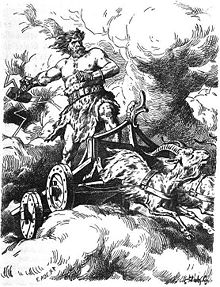Tanngrisnir and Tanngnjóstr

In Norse mythology, Tanngrisnir (Old Norse "teeth-barer, snarler") and Tanngnjóstr (Old Norse "teeth grinder") are the goats that pull the god Thor's chariot. The goats are attested in the Poetic Edda, compiled in the 13th century from earlier traditional sources, and the Prose Edda, written by Snorri Sturluson in the 13th century.
The Prose Edda relates that when Thor cooks the goats, their flesh provides sustenance for the god, and, after Thor resurrects them with his hammer, Mjöllnir, they are brought back to life the next day. According to the same source, Thor once stayed a night at the home of peasant farmers and shared with them his goat meal, yet one of their children, Þjálfi, sucks the marrow from a goat bone, resulting in the lameness of one of the goats upon resurrection. As a result, Thor maintains Þjálfi and his sister Röskva as his servants.
Etymology
The Old Norse name Tanngrisnir translates to "teeth-barer, snarler" and Tanngnjóstr to "teeth-grinder". Scholar Rudolf Simek comments that the names were young when recorded, and may have been inventions of Snorri.[1] Tanngnjóstr sometimes modernly anglicized as Tanngiost.[2]
Attestations
Poetic Edda

Thor's goats are mentioned in two poems in the Poetic Edda, though they are not referred to by name. In the Poetic Edda poem Hymiskviða, Thor secures the goats, described as having "splendid horns", with a human named Egil in the realm of Midgard before Thor and the god Tyr continue to the jötunn Hymir's hall.[3] Later in the same poem Thor is referred to as "lord of goats".[4]
A stanza from the Poetic Edda poem Þrymskviða describes Thor's goat-driven ride to Jötunheimr:
- Benjamin Thorpe translation:
- Straightway were the goats homeward driven,
- hurried to the traces; they had fast to run.
- The rocks were shivered, the earth was in a blaze;
- Odin's son drove to Jötunheim.[5]
- Henry Adams Bellows translation:
- Then home the goats to the hall were driven,
- They wrenched at the halters, swift were they to run;
- The mountains burst, earth burned with fire,
- And Odin's son sought Jotunheim.[6]
Prose Edda
In chapter 21 of the Prose Edda book Gylfaginning, the enthroned figure of High divulges that the god Thor has two goats that drive his chariot and that these goats bear the names Tanngnjóstr and Tanngrisnir.[7]
In chapter 44, the enthroned figure of Third reluctantly relates a tale in which Thor and Loki are riding in Thor's chariot, pulled by his two goats. Loki and Thor stop at the home of a peasant farmer, and there they are given lodging for a night. Thor slaughters his goats, skins them and puts them in a pot. When the goats are cooked, Loki and Thor sit down for their evening meal. Thor invites the peasant family to share the meal with him and they do so.[8]
At the end of the meal, Thor places the skins of the goat on the opposing side of the fire and tells the peasants to throw the bones of the goats on to the goatskins. The peasant's son Þjálfi takes one of the goat ham-bones and uses a knife to split it open, breaking the bone to get to the marrow.[8]
After staying the night, Thor wakes up and gets dressed before the break of dawn. Thor takes his hammer Mjöllnir, raises it, and blesses the goat skins. Resurrected, the goats stand, but one of the two goats is lame in the hind leg. Noting this new lameness, Thor exclaims that someone has mistreated the bones of his goats; that someone broke the ham-bone during the meal the night before. Third notes that there is no need to draw out the tale, for:
- Everyone can imagine how terrified the peasant must have been when he saw Thor making his brows sink down over his eyes; as for what could be seen of the yes themselves, he thought he would collapse at just he very sight. Thor clenched his hands on the shaft of the hammer so that the knuckles went white, and the peasant did as one might expect, and all his household, they cried out fervently, begged for grace, offered to atone with all their possessions.[8]
At realizing how terrified he has made the peasants, Thor calms down and from them accepted a settlement of their children Þjálfi and Röskva. The two children become his servants and have remained so since. Leaving the goats behind, the four then set out for the land of Jötunheimr.[8] The goats are again mentioned in chapter 48, where Thor is described as setting out to Midgard, the realm of mankind, in the form of a young boy, without goats or companions.[9]
In chapter 75 of the Prose Edda book Skáldskaparmál, the names of both goats appear among a list of names for goats.[10]
See also
- Heiðrún, a goat that lives on top of the afterlife hall Valhalla
- Yule goat, a Scandinavian Yule tradition
Notes
References
- Bellows, Henry Adams (1923). The Poetic Edda. American-Scandinavian Foundation.
- Faulkes, Anthony (Trans.) (1995). Edda. Everyman. ISBN 0-460-87616-3
- Larrington, Carolyne (Trans.) (1999). The Poetic Edda. Oxford World's Classics. ISBN 0-19-283946-2
- Simek, Rudolf (2007) translated by Angela Hall. Dictionary of Northern Mythology. D.S. Brewer. ISBN 0859915131
- Thorpe, Benjamin (Trans) (1866) The Elder Edda of Saemund Sigfusson. Norrœna Society.
